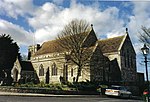Dancing Ledge
Dorset geography stubsGeography of DorsetGeology of DorsetIsle of PurbeckJurassic Coast ... and 1 more
Vague or ambiguous time from April 2017

Dancing Ledge is part of the Jurassic Coast near Langton Matravers in the Isle of Purbeck in Dorset, England. Dancing Ledge is a flat area of rock at the base of a small cliff. A little scrambling is required for access. It is signposted on the South West Coast Path a few kilometres west of Swanage. Dancing Ledge is so called because at certain stages of the tide when the waves wash over the horizontal surface, the surface undulations cause the water to bob about making the ledge appear to dance.
Excerpt from the Wikipedia article Dancing Ledge (License: CC BY-SA 3.0, Authors, Images).Dancing Ledge
Priest's Way,
Geographical coordinates (GPS) Address Nearby Places Show on map
Geographical coordinates (GPS)
| Latitude | Longitude |
|---|---|
| N 50.591763888889 ° | E -2.0045 ° |
Address
Dancing Ledge
Priest's Way
BH19 3HG , Langton Matravers
England, United Kingdom
Open on Google Maps







